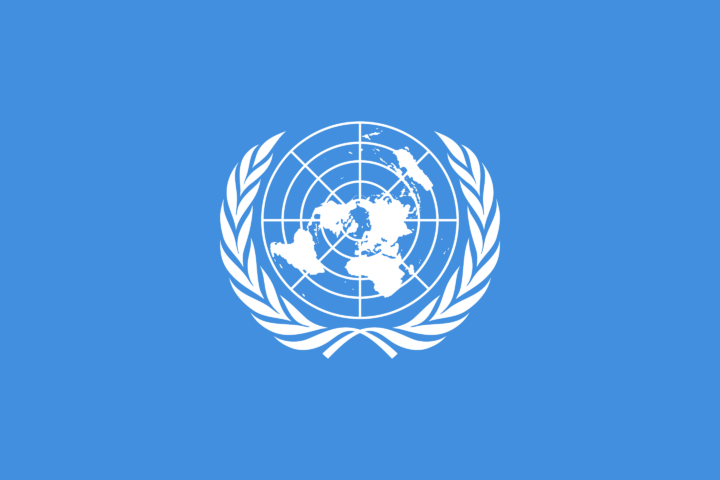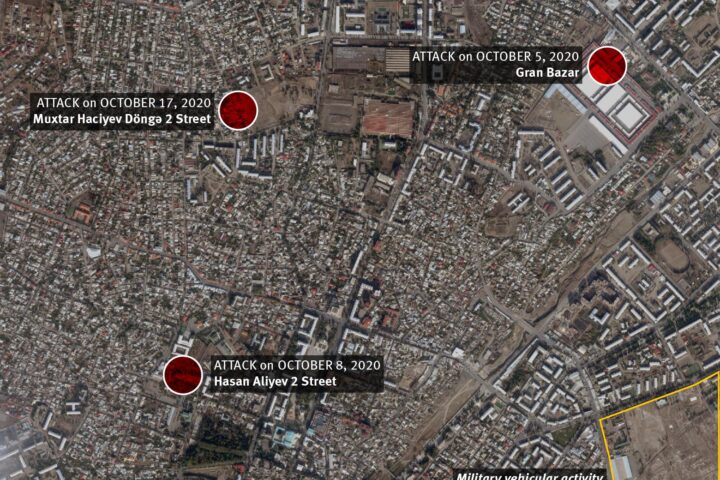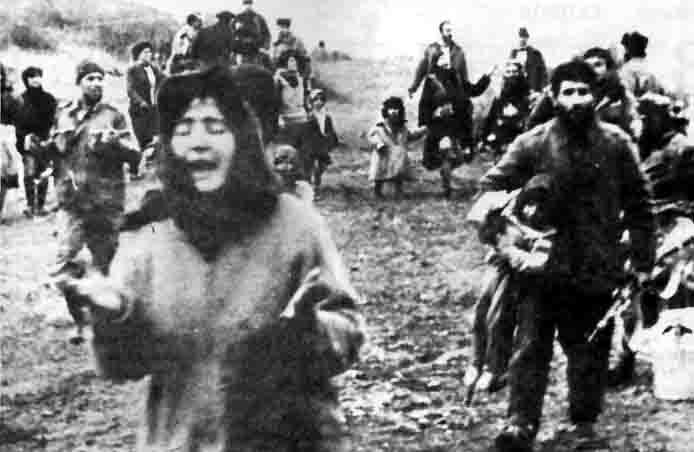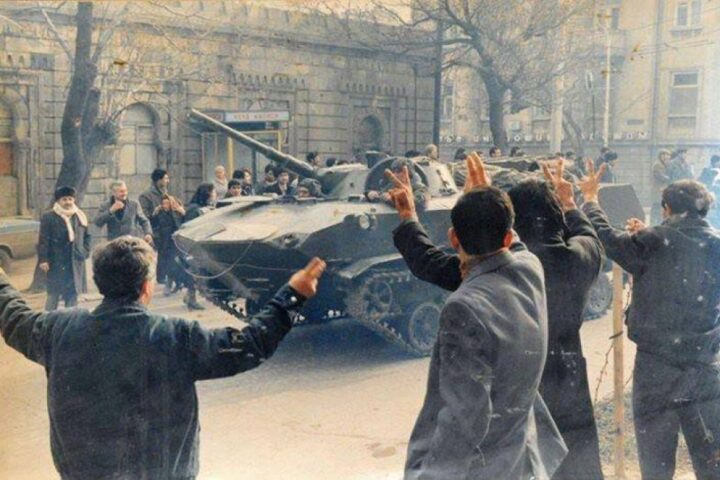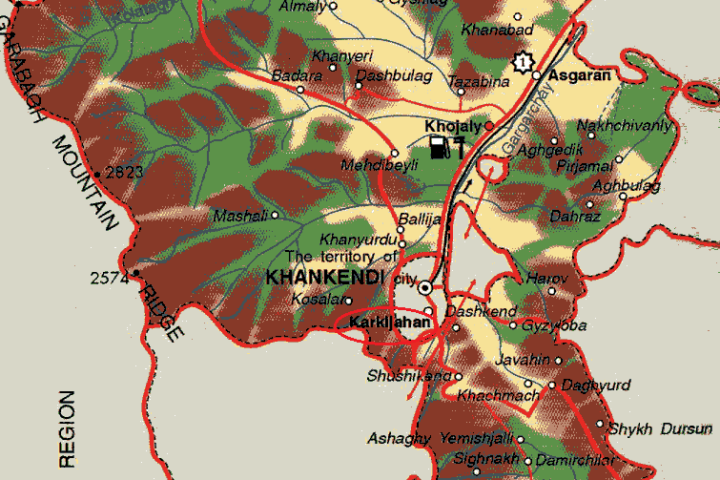ABSTRACT
This article deals with the international legal aspects of the Armenian-Azerbaijani Nagorno-Karabakh conflict. In reference to this conflict, the author examines such burning questions of modern international law as the principle of territorial integrity of states and the right of peoples to self-determination, makes assessment of this conflict from the angle of international law, and considers various state-legal aspects of its settlement.
Background to the Conflict
The conflict known throughout the world as the “Nagorno-Karabakh” conflict arose parallel to the disintegration of the U.S.S.R. Favorable conditions for its development were created by processes that were at work in the Soviet Union from the mid-1980s. At the same time, the Nagorno-Karabakh conflict, encouraged by the U.S.S.R. authorities led by Mikhail Gorbachev, served as a catalyst of centrifugal processes, triggering off numerous ethnic and territorial conflicts in the post-Soviet space and transforming the evolutionary process of the U.S.S.R.’s disintegration into a revolutionary breakup.
From the very beginning of the events in Nagorno-Karabakh, the term “conflict” was used as a cover for the aggressive policy pursued by the Republic of Armenia toward its neighboring country. This concept continues to be used today in the peaceful settlement process despite the existence of international documents in which the occupation of Azerbaijani territories by the Republic of Armenia has already been given an objective political and legal assessment. Let us note that the term “conflict” contains a certain degree of “neutrality” in determining the party guilty of the fact in question. Nevertheless, we use this term in this article so as not to be accused of bias from the very beginning.
The active phase of the conflict started in February 1988, when the separatist forces of the Nagorno-Karabakh Autonomous Region (NKAR) of the Azerbaijan Republic, instigated by the Republic of Armenia, began to stage rallies, strikes and other civil disobedience actions, seeking a secession of the region from the Azerbaijan Republic and its incorporation into the Republic of Armenia. It should be noted that the NKAR’s legal status—according to the Constitution of the U.S.S.R. and the Constitution of the Azerbaijan S.S.R.—was determined by the Law on the Nagorno-Karabakh Autonomous Region, adopted on 16 June, 1981, by the Supreme Soviet of the Azerbaijan Republic on the motion of the NKAR Soviet of People’s Deputies.1On 20 February, 1988, a session of the NKAR Soviet of People’s Deputies adopted a decision On the Petition of NKAR Deputies for the Transfer of the NKAR from the Azerbaijan S.S.R. to the Armenian S.S.R.2Ethnic cleansing of Azeris began in the Republic of Armenia and in the territory of Nagorno-Karabakh, with the creation of monoethnic Armenian areas.3
As a result of the first stage, on 1 December, 1989, the Supreme Soviet of the Armenian S.S.R. adopted a resolution On the Reunification of the Armenian S.S.R. and Nagorno-Karabakh. In its resolution of 10 January, 1990, On the Inconsistency with the Constitution of the U.S.S.R. of the Acts on Nagorno-Karabakh Adopted by the Supreme Soviet of the Armenian S.S.R. on 1 December, 1989, and 9 January, 1990, the Presidium of the U.S.S.R. Supreme Soviet unequivocally stated that “the proclamation of the reunification of the Armenian S.S.R. and Nagorno-Karabakh without the consent of the Azerbaijan S.S.R. is a direct violation of Art 78 of the U.S.S.R. Constitution.”4The Azerbaijan Republic abolished the NKAR and extended its uniform administrative-territorial division to that territory.5
All of that was the result of a deliberate policy pursued by the Republic of Armenia, the Armenian Church and diaspora in order to annex, including by force, the mountainous (Nagorno) part of Karabakh from the Azerbaijan Republic and to incorporate it into Armenia. The conflict moved into a new phase—the phase of active hostilities—in late 1991 and early 1992, when the U.S.S.R. had ceased to exist as a subject of international law and when the last legal and organizational (except international legal) barriers to the annexation of the desired territories had been removed.
By mid-1994, the armed forces of the Republic of Armenia, supported by the illegal Armenian armed formations of Nagorno-Karabakh, occupied areas of the Azerbaijan Republic bordering on the Republic of Armenia, the territory of the former NKAR proper and other areas of the Azerbaijan Republic adjacent to it, totaling about 20% of the entire territory of the Azerbaijan Republic. All Azeris were expelled from these territories, tens of thousands were killed and hundreds of thousands wounded. As regards the scale of destruction, let us merely note that Armenian-occupied territories not inhabited by Armenians are now a desert: everything has been wiped out. Incidentally, this was established in the spring of 2005 by an OSCE fact-finding mission.
In the territory of the former NKAR and other occupied areas of the Azerbaijan Republic, we have seen the establishment of a so-called “Nagorno-Karabakh Republic” with its own government bodies and attributes of power. However, not a single state or international organization in the world has recognized such a state as the “NKR.”
International Legal Assessment of the Conflict
In the modern world,the emergence of new states is a process and phenomenon not encouraged by the world community,so that in practice such cases are very rare. This happened, for example, in the first half of the 1990s, when the Soviet Union fell apart into 15 independent states, when new countries emerged in place of the Socialist Federal Republic of Yugoslavia (SFRY) and the Czechoslovak Socialist Republic (C.S.S.R.), and when Germany was unified. Despite the dramatic events that accompanied these processes, the emergence of new independent states was based onlegal treaties(in various legitimate forms), i.e., agreements on the creation of these states recognized by the world community. This made it possible to go over in a civilized way from state entities created by force of arms, through violence, conquest and subjugation (U.S.S.R., SFRY, C.S.S.R.) to independent states set up on the basis of voluntary treaties and therefore recognized by other democratic states.
In that period, other events took place as well. On the tide of democratic processes in the Southern Caucasus, nationalist forces using democratic and national-liberation slogans as a cover tried to create new states by force, by revising borders, i.e., by violating the principle of territorial integrity and inviolability of borders (Nagorno-Karabakh in Azerbaijan, Abkhazia and South Ossetia in Georgia, Transdniestria in Moldova and Chechnia in Russia). However, none of these cases has to do with a legal treaty recognized by the world community. The reason is obvious:the modern world community does not regard violence or coercion as a way or method of creating a new state. The creation of a new state in today’s democratic world is possible only in the presence of a legal treaty, when all the parties concerned come to a voluntary agreement to revise their borders.A treaty can have no legal force if one of the parties is coerced into altering its borders by force of arms; such a treaty is legally null and void and, sooner or later, it will be violated and denounced. In addition, it will constantly be a potential source of instability in the region.The fact of international recognition of a state created through the occupation of another state’s territories could be regarded in the world as a precedent, entailing unpredictable consequences for the global community.It is no accident that none of the above-mentioned entities have been recognized by a single state, including the Republic of Armenia.
An international conflict can be resolved only when the world community makes anobjective political and legal assessmentof that conflict. An allround, full and exhaustive study of the root causes of the conflict and an assessment of the situation at the time of decision making is absolutely essential for:
(1) the adoption of a fair decision by the parties (with the participation of mediators);
(2) legally correct and effective use of generally recognized rules of international law;
(3) the establishment of a stable and lasting peace guaranteed by the international community.
The world community, as we know, is represented by authoritative international organizations such as the United Nations, OSCE, European Union, Council of Europe, NATO and others, whose immediate duty is to maintain and restore peace and stability both on a global scale and in various parts of the world, and to apply sanctions against the aggressor country.
On 25 January, 2005, the Parliamentary Assembly of the Council of Europe adopted its Resolution 1416 (2005), The Conflict over the Nagorno-Karabakh Region Dealt with by the OSCE Minsk Conference (rapporteur David Atkinson), acknowledging the occupation of a significant part of Azerbaijan’s territory by Armenian troops and emphasizing that “the occupation of foreign territory by a member state constitutes a grave violation of that state’s obligations as a member of the Council of Europe.”6The Resolution can be hopefully regarded as only the first, albeit belated, step in this direction. Such documents containing a political and legal assessment of the Nagorno-Karabakh conflict should also be adopted by other international organizations, primarily the OSCE, which provides the framework for the ongoing Minsk negotiation process.
The lack of an objective political and legal assessment does not encourage, in the first place, the parties to the conflict to show goodwill for the purpose of its resolution. The lack of such an assessment also serves (as is the case today) to prolong the conflict and to create illusions among certain forces that in this way it is possible to overstep the rules of international law, to occupy a sovereign state’s internationally recognized territory and, once these acts have been committed, to achieve the desired results in the negotiation process. Let us recall that the Azerbaijan Republic and the Republic of Armenia signed the Helsinki Final Act, so recognizing, in accordance with their constitutions:
(1) the supremacy of the provisions of this Act in both internal and external legal relationships;
(2) the principles of inviolability of borders and territorial integrity of states.7
Only an objective position of the world community can make it possible to withdraw the armed forces deployed in the conflict zone and to resolve the conflict by peaceful means, without military pressure and on the basis of the principles of international law.
International Legal Potential for Resolving the Conflict
In view of the need to resolve the conflict, questions about theform of government(state structure) arise with increasing frequency. The doctrine of constitutional and international law is sufficiently conservative in its definitions. That is why scholars have tried for many decades to fit all the models of actually existing states into the framework of the concepts of “confederation,” “federation” and “unitary state.” At the same time, a political and legal analysis of empirical reality shows that in pure form these categories are virtually nonexistent: their elements are interlinked to such an extent that one can speak of the emergence of various hybrid forms. For example, there are generally recognized federal states whose constituent entities are nevertheless entitled to conclude international treaties (Austrian lands, territorial entities of Bosnia-Herzegovina).
Inductive methods used to investigate these problems lead to certain definitive generalizations. In our view, an analysis of various existing ways of state organization suggests the conclusion that, depending on the relations between the state and its component parts, today we can identify the following generalized forms of government: confederation, federation, unitary regional state and unitary state with special autonomous status for some of its territories. In this context, a “blind” approach to traditional concepts, definitions and classifications often produces an opposite effect. An attempt to fit current realities into a definitive framework could lead to a simplification or, even worse, to a distortion of the existing constitutional diversity, and in the process of conflict resolution this could become an obstacle blocking the way to a settlement. That is whyin settling an ethnoterritorial or ethnopolitical conflict one should bear in mind the doctrinal concepts and definitions of constitutional and international law, consider the constitutional and international legal realities existing in the world, and be prepared to make unorthodox, non-routine decisions in order to resolve the given conflict.
A few words aboutthe right of peoples to self-determination, so mercilessly exploited by Armenian politicians. It should be noted that Azerbaijan, relying on the norms of international law, from the very beginning categorically rules out the possibility of applying the “self-determination of peoples” principle to the problem of Nagorno-Karabakh based on a whole range of fairly well-known arguments.
First,Nagorno-Karabakh is a territorial region of Azerbaijan. The Azerbaijan Republic as a sovereign state is the result of an expression of the will and self-determination of the entire Azerbaijani people (including ethnic Armenians) living throughout the whole territory of the Azerbaijan Republic, and certainly not of a part of this people. A part of the people cannot make decisions that are crucial to the future of the whole people. In accordance with U.N. General Assembly Resolution 47/135 of 18 December, 1992, Declaration on the Rights of Persons Belonging to National or Ethnic, Religious and Linguistic Minorities,the principle of self-determination of peoples is not included among the rights of national minorities:the international community did not consider it possible or necessary to reflect this principle in the Declaration.8
Second,having signed the Helsinki Final Act in 1975, the countries of Europe, the U.S. and Canada tied in the principle of equal rights and self-determination of peoples, as written into the Declaration on Principles of International Law Concerning Friendly Relations and Cooperation among States in Accordance with the Charter of the United Nations (24 October, 1970), with the principle of territorial integrity of states. The Declaration says that effective application of the principle of equal rights and self-determination of peoples “is of paramount importance for the promotion of friendly relations among states, based on respect for the principle of sovereign equality.” The principle of self-determination can find its application only in the context of the principle of territorial integrity of states. The Declaration proclaims that “any attempt aimed at the partial or total disruption of the national unity and territorial integrity of a state or country or at its political independence is incompatible with the purposes and principles of the Charter.”9This is precisely why the Helsinki Final Act put this principle in eighth place (out of ten) and called it “the principle of equal rights and self-determination of peoples.”10
Third,Nagorno-Karabakh is a region of Azerbaijan where, prior to the ethnic cleansing carried out by Armenians, there were two communities (Armenian and Azeri). They constitute the population of Nagorno-Karabakh, but by no means a “people.” “People” is a political category, and peoples in this context are “the Armenians” and “the Azerbaijanis,” who have already implemented their right to self-determination within the framework, respectively, of the Republic of Armenia and the Azerbaijan Republic. The term “people” cannot be applied to the population of Nagorno-Karabakh as part of the Azerbaijan Republic.
Fourth,even if we assume the impossible and say that the population of Nagorno-Karabakh consisting of Armenians and Azeris is a people with a right to self-determination, this will not mean that Nagorno-Karabakh should secede from the Azerbaijan Republic. Under section five of the 1970 Declaration on Principles of International Law, advocacy of the principle of self-determination is not equivalent to encouragement of secession or fragmentation of countries. This Declaration explicitly states that the principle of self-determination can and must find its solution within the framework of the principle of inviolability of borders and the principle of territorial integrity of states; this principle “should not be construed as authorizing or encouraging any action which would dismember or impair, totally or in part, the territorial integrity or political unity of sovereign and independent states… Every state shall refrain from any action aimed at the partial or total disruption of the national unity and territorial integrity of any other state or country.”11
Andfifth,neither the theory nor the practice of international or constitutional law has ever had to deal with cases of repeated exercise of the right of peoples to self-determination. If we assume the impossible and suppose that such a precedent is actually created in practice, many countries in the world (including Russia, the U.S., France, Turkey, Canada, Australia, Iran, Georgia, Uzbekistan, Kyrgyzstan, Ukraine, Spain, Holland, Bulgaria, Lebanon, Syria and others) will be faced with the inevitable need to somehow resolve the issue of Armenian self-determination.
The possibility of recognition of “NKR” independence.Some political forces seek to provide a number of reasons allegedly sufficient to recognize the independence of the “NKR” and to split it off from the Azerbaijan Republic. The main argument in this matter is that the “NKR,” in the opinion of its founders, is a “more democratic entity” than the Azerbaijan Republic and that these “democrats” need greater “freedom and independence.”
Without comparing the democratic situation in the Azerbaijan Republic and in the Nagorno-Karabakh region that is no longer under its control, let us merely take a look at how “democratic” is the self-proclaimed “NKR.”
Lawyers, diplomats, political scientists, historians and many other specialists are well aware that the concept of “state” includes three main components: sovereign power, population and territory. Consequently, in order to recognize the so-called “NKR” as capable and worthy of existence as an independent democratic state, the world community will have to ascertain that all these three components are in evidence. Leaving aside the will of the Azerbaijan Republic and its people on this issue, let us examine each of these components.
First, sovereign power.But undoubtedly, its source should be the people. We have already shown that the population of Nagorno-Karabakh is not a people. Sovereign power should be independent. But there is reason to believe that no self-respecting politician, lawyer, diplomat, political scientist or historian will try to prove the independence or sovereignty of power in the so-called “NKR,” if only because of the presence in its life of the Republic of Armenia.
Second, population.Who inhabits the “NKR” today? From the beginning of the occupation of Azerbaijani territories by the Republic of Armenia, the territory of the former NKAR was abandoned, under threat of force, by all ethnic Azerbaijanis (Azeris), who made up in that period about one-third of the NKAR’s inhabitants (over 60 thousand people). In addition, a part of the ethnic Armenian population (about 25-30 thousand people) also left Nagorno-Karabakh because they did not want to take part in the hostilities or acts of lawlessness in its territory. Considering the facts of illegal settlement in Azerbaijani territories occupied by the Republic of Armenia, the population of the so-called “NKR” is about 100 thousand. Clearly, none of the above fits into the framework of democratic processes. How about the Azeri population of Nagorno-Karabakh? What is to be done about their rights in the process of “recognition of NKR independence”?
Third, territory.What kind of territory should be borne in mind in determining the territory of the “NKR”? The former territory of the former Nagorno-Karabakh Autonomous Region of the Azerbaijan S.S.R. or the entire territory occupied by the armed forces of the Republic of Armenia, which includes, apart from the territory of the former NKAR, seven other administrative districts of Azerbaijan? If we take the territory of the former NKAR alone, then how about the rights of the expelled part of the population? And if we take the territory of the NKAR plus seven administrative districts, then how about the rights of over 700 thousand Azerbaijani citizens expelled from their lands for the sake of the security of 100 thousand Armenians? It is unlikely that any “democrat” will be able to answer these questions.
Conclusion
Sergey Markedonov, head of the International Relations Department at the Moscow Institute of Political and Military Analysis, said in the context of the Nagorno-Karabakh conflict: “…There is no need to appeal to history in current conflicts. History? Let us leave it to historians, and let them search through the archives. Evidently, the future cannot be built by appealing to the past. Frankly speaking, the historicization of a conflict is not the best way to overcome it.”12
But if one has to appeal to history, this should not be done selectively, when certain pages are torn out of the peoples’ common book of fate, but based on a uniform, objective scientific approach to the whole range of historical facts and phenomena.
Unfortunately, this is often forgotten when it comes to the falsified “1915 genocide of Armenians.” Honestly, it is amazing how easily, in case of need, we are distracted from history, from historical experience. How can the future be built without regard for the past? How can lasting peace be established in Nagorno-Karabakh and in the Southern Caucasus without taking into account past historical mistakes? A poor memory is precisely what enables conflicts to flare up again and again. Building peace without regard for history is precisely what made this peace short-lived. Evidently, someone was interested in this. Today we are witnessing an attempt to repeat history. Peace should be built with due regard for history and past historical mistakes. Peace in the Southern Caucasus should be built so as to ensure that no one reaps any dividends (but only draws lessons) from what has taken place, because otherwise after a short historical time someone will be tempted to repeat these events and to seize some more land. If anyone thinks that their problems (including territorial problems) can be resolved by force of arms, there will be no peace—lasting peace—in the world or in our region.
1See:O Nagorno-Karabakhskoi avtonomnoi oblasti. Zakon Azerbaidzhanskoi S.S.R., Azerneshr, Baku, 1987.Back to text
2See:Nagornyi Karabakh: razum pobedit. Dokumenty i materialy, Azerneshr, Baku, 1989, pp. 81-82.Back to text
3See: The Conflict over the Nagorno-Karabakh Region Dealt with by the OSCE Minsk Conference. Resolution 1416 (2005) of the Parliamentary Assembly of the Council of Europe, available at [http://assembly.coe.int].Back to text
4See:Vedomosti Verkhovnogo Soveta SSSR, No. 3, 1990, Art 38.Back to text
5See: “Ob uprazdnenii Nagorno-Karabakhskoi avtonomnoi oblasti Azerbaidzhanskoi Respubliki. Zakon Azerbaidzhanskoi Respubliki ot 26 noiabria 1991 goda,”Vedomosti Verkhovnogo Soveta Azerbaidzhanskoi Respubliki, No. 24, 1991, Art 448.Back to text
6See: [http://assembly.coe.int].Back to text
7See: Final Act of the Conference on Security and Cooperation in Europe (Helsinki, 1 August, 1975), available at: [http://www.wilsoncenter.org/subsites/ccpdc/pubs/addm/oscefr.htm].Back to text
8See: [http://www.un.org/russian/documen/gadocs/convres1990.htm].Back to text
9See: [http://www.terralegis.org/terra/act/b252html].Back to text
10See: [http://www.terralegis.org/terra/act/b252html].Back to text
11See: [http://www.terralegis.org/terra/act/b252html].Back to text
12See: “Karabakhski konflikt: vzgliad izvne,”Zerkalo, 13 August, 2005, p. 10.Back to text





